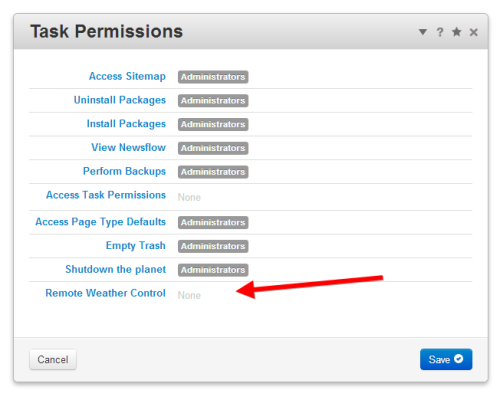When you build an add-on with concrete5, you’ll sometimes want to hide a few things depending on the users or group. You might be tempted to hard-code a check to a specific group, but there’s a much more elegant way to handle this. It also gives you a lot more power to control who’s allowed to do something, just in case your customer changes.
In this tutorial, we’re building a new package called “codeblog_task_permissions” which you have to put in your “packages” directory. Within the new package directory, create a new file called “controller.php” and put the following content in it, we’ll have a closer look at what it does afterwards:
1 2 3 4 5 6 7 8 9 10 11 12 13 14 15 16 17 18 19 20 21 22 23 24 25 26 27 28 29 30 31 32 33 34 35 36 37 38 39 40 41 42 43 44 45 46 47 48 49 50 | <?php class TaskPermissionsPackage extends Package { protected $pkgHandle = 'task_permissions'; protected $appVersionRequired = '5.6.3'; protected $pkgVersion = '1.0'; public function getPackageDescription() { return t("Installs the Task Permission demo package."); } public function getPackageName() { return t("Task Permissions"); } public function install() { $pkg = parent::install(); $this->installTaskPermissions($pkg); } /** * This method installs our permission keys * * @param Package $pkg */ protected function installTaskPermissions($pkg) { // add a new permission key to handle shutdons $pkShutdownHandle = 'shutdown_planet'; if (!is_object(PermissionKey::getByHandle($pkShutdownHandle))) { $pkShutdown = PermissionKey::add('admin', $pkShutdownHandle, t('Shutdown the planet'), t('Permission to shutdown the planet'), '', '', $pkg); // assign administrators the right to handle our planet $group = Group::getByID(ADMIN_GROUP_ID); $adminGroupEntity = GroupPermissionAccessEntity::getOrCreate($group); $pa = PermissionAccess::create($pkShutdown); $pa->addListItem($adminGroupEntity); $pt = $pkShutdown->getPermissionAssignmentObject(); $pt->assignPermissionAccess($pa); } // install a second permission key to control the weather $pkWeatherHandle = 'make_weather_nice'; if (!is_object(PermissionKey::getByHandle($pkWeatherHandle))) { $pkWeather = PermissionKey::add('admin', $pkWeatherHandle, t('Remote Weather Control'), t('Access to the remote weather control system'), '', '', $pkg); } } } |
Let’s have a look at the simpler example. In line 44 we’re setting the handle of the permission key, it’s what we need to work with it when we run our check in the code. In the next line, we check if the permission key is already installed, if it isn’t, we add it. These are the parameters you can use:
public static function add( $pkCategoryHandle, $pkHandle, $pkName, $pkDescription, $pkCanTriggerWorkflow, $pkHasCustomClass, $pkg = false ) |
That’s all we need to add a custom attribute key. If you install the package and navigate to “/dashboard/system/permissions/tasks/” in your dashboard, you’ll see your custom permission keys at the end of the screen.
As you can see, our new permission key doesn’t have any groups assigned to it. You can either do that manually, or by code. In the example above, the first permission key shows you how to do that. Just have a look at the lines 33 to 40. We get an instance of our administrators group and then pass it along a permission access object which we can assign to our permission key.
Now that we have created our permission keys, we want to use them. This part is even easier, all you have to do is to create a PermissionKey object and run the “can()” method:
1 2 3 4 5 6 | $pk = PermissionKey::getByHandle('shutdown_planet'); if ($pk->can()) { echo t('Yes you are allowed to shutdown the planet'); } else { echo t('We are sorry but you have no permissions to shutdown the planet'); } |
You can find the complete example on github, https://github.com/Remo/codeblog/tree/master/codeblog_task_permissions. If you use the example and want to check the permissions, point your browser to http://

8 Comments
This is great Remo. Thanks for putting this together. Very nice.
Thanks Chad! Glad you like it
Is this website run on WordPress or Concrete5? Looks like WP.
Despite the fact that I’m writing a lot about concrete5, I’m using WordPress for this site. If it’s just about blogging, WordPress feels still more natural to work with. At least to me 😉
As always, thank you for very useful tutorials Remo! Those more advanced topics are priceless when you need them.
This example was very helpful to me, but there is one thing I’m having an issue with.
The assignment sequence, lines 33 to 40 seems to replace any currently assigned groups.
I can add multiple groups by repeating line 38 for each group object. So, If i could get a list of currently assigned groups, I could add them back in.
However I do not know how to retrieve a list of such groups. I see how i might do that from the database, but I’d rather stick to the API.
Any suggestions?
I think you should be able to duplicate the permission assignment object as shown here https://legacy-documentation.concrete5.org/tutorials/programmatically-setting-advanced-permissions
Thanks Remo. This seems to be on the right track but still having issues. In my adaptation of the code examples you give and cite. $pk->getPermissionAccessID() returns null, causing $paGlobal = PermissionAccess::getByID($accessId, $pk) also to return null.
Here is my full example
/**
* @param $permissionKey string handle for permission
* @param $roleName string handle for group
* @param bool $delete revoke if true, assign if false, default false
* @return bool
*/
private function assignPermissionGroup( $permissionKey, $roleName,$delete=false)
{
$group = Group::getByName($roleName);
if (empty($group)) {
return false;
}
/**
* @var $pkObject \Concrete\Core\Permission\Key\Key
*/
$pkObject = \Concrete\Core\Permission\Key\Key::getByHandle($permissionKey);
/**
* @var $permissionAssignment \Concrete\Core\Permission\Assignment\Assignment
*/
$permissionAssignment = $pkObject->getPermissionAssignmentObject();
// Error!! $accessId assigned null;
$accessId = $pkObject->getPermissionAccessID();
/**
* @var $paGlobal PermissionAccess
*
* Warning, $paGlobal must be duplicated per the statement below. Any other methods applied will affect all Task permissions.
*/
$paGlobal = PermissionAccess::getByID($accessId, $pkObject);
/**
* @var $permissionAccess PermissionAccess
*/
$permissionAccess = $paGlobal->duplicate();
/**
* @var $groupEntity GroupPermissionAccessEntity
*/
$groupEntity = GroupPermissionAccessEntity::getOrCreate($group);
if ($groupEntity === null) {
return false;
}
if ($delete) {
$permissionAccess->removeListItem($groupEntity);
} else {
$permissionAccess->addListItem($groupEntity);
}
$permissionAssignment->assignPermissionAccess($permissionAccess);
return true;
}